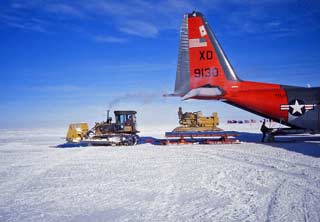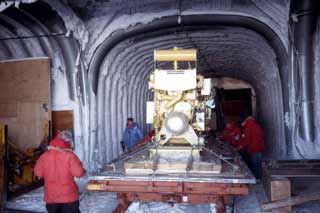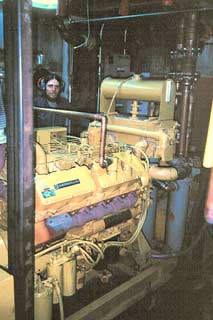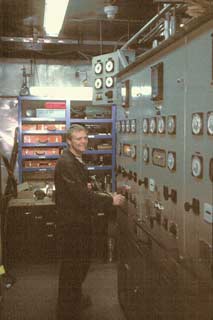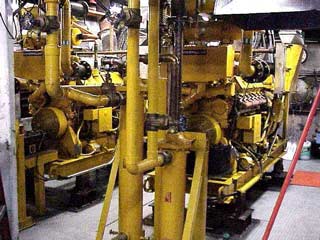Power Plant Upgrade 1989-90
|
So I proposed the same thing for Pole...first, of course, doing a power usage projection based on historical usage and science growth. And as with the Palmer project, I was trying to keep the cost down...after all, my supervisors would have to present the project to NSF for approval. So...I opted for the engine power ratings that I thought would meet the station requirements until the future to-be-designed new station power plant would come on line...I kept things simple--no wet silencers, dual turbos etc...in part to avoid making the walkways between the engines too narrow. NSF bought off on the project in early 1988--after the Palmer project had been approved and materials purchased, but before we'd done the installation. The timeline for the Pole project required the new generator sets to be shipped south on the vessel to arrive at McMurdo in January 1989...so as to be available for installation in 1989-90. So not long before I went to Palmer for that project installation, I spent a few days in Peoria witnessing the tests of the Pole engines, generators, and radiators--an interesting few days...the packager who the system was bought from took me out for dinner and drinks before the first part of the tests...which went into the wee hours of the morning. And when I returned to check in to my hotel ("guaranteed reservation") I walked into the room to discover that it was huge, apparently used for displays and presentations...but that it lacked a bed. So I called the front desk...they had no other rooms available, but at this point instead of insisting that they find me a room at another hotel per the guarantee, The three engine generators did arrive at McMurdo on the January 1989 vessel, and they were stored for the winter in the heated warehouse on Observation Hill at the old nuclear/water plant site. The power plant addition, which would house some of the new pumps and piping as well as the radiator enclosure, had been designed by the Pole O&M folks and completed during the 1989 winter. We got a late start with the actual generator installation due to bad weather and an asbestos survey (a military team was brought in to investigate and remediate). Some of what they found would eventually complicate the demolition of the power plant in 2007-08 as well as the weight room, but no asbestos was found that would affect this project. 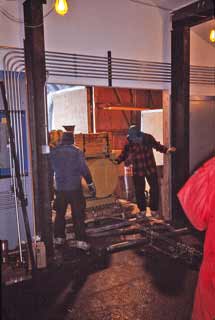
After a fairly significant exercise involving one tractor pulling the sled and a second one in the biomed arch (above left--coordinator Mike "nude" Patterson is in the blue coat on the left side of the sled), the sled was rotated 90º and backed up to some temporary rails so that the generator could be moved to the new loading dock. At right, we're slowly pulling it in to the power plant through the addition, using come-alongs, pipe rollers, and some brute force. 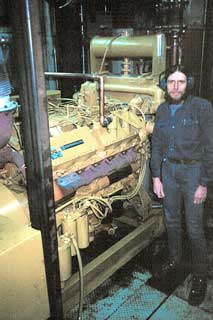
At left, I'm standing in front of our new #1 engine in February 1990. During the 1989-90 season we installed the new radiators and plenum, most of the new piping system, and rewired all 3 switchgear cubicles. Because of the late start, we ended up deferring the replacement of the other two engines until the following season. During the 1990 winter this engine operated most of the time, except for scheduled PM's when the dreaded power conservation calls had to go out. This engine was successfully load-tested to 350 kw with the help of a load bank; the power output was limited by the cooling system and high exhaust temperatures. Of course our station load design criteria was more like 250 kw so the project was considered successful. Part of the problem with the engine cooling was that my design had to accommodate a lot of extra piping (and added friction/inefficiency) to allow for switching back and forth between new and old engines. Of course And before the project was completed, a major new (and power-hungry) science complex was being designed and built in the dark sector--something that I had not been aware of when I did the original power projections. So...the engines ended up being "souped up" in the field with bigger turbos, wet silencers, and On the right is another look with a bit more of the engine and a bit less of me. The late 90s winterovers Joel and Robert have better pictures of this place as it was finished, but the neatest ones I've seen are in the video that Caterpillar used in a CNN ad for a few years in the mid '90's. At left, 1990 w/o power plant mechanic Roger Carr throws the breaker to put #1 on line. This is what the switchgear looked like as I left it; in addition to the design, I did most of the panel wiring plus the functional checkout. One thing you see in this picture that I did NOT think of (but I helped them do it) was to raise the synchronization panel you see above Roger's head. Up until about 1988 it was down lower and a real head knocker. | |
|
Of course, by the time these pictures were taken, the new power plant was already under construction. When it was completed, this old facility was used only to backfeed power (and heat) to the older dome facilities. Engine #2 was removed, the waste heat from the new plant was piped to a new heat exchanger that replaced the engine #2 exchangers, and electricity was fed to the dome facilities through the engine #2 circuit breaker. This was the configuration as of 2005, and the two remaining engines still served as an emergency power plant...until 2006 when the final connections from the new emergency power plant in the elevated station were completed. But...this plant had one last hurrah...on 6 April 2006, the new power plant suffered a brief outage. Another generator was started quickly, but the transformer supplying power to the old dome power plant (which still fed power to remaining dome facilities and the fuel arch) failed. As a result, there was no way to pump fuel in the new power plant day tanks. Until 2006 w/o power plant mechanic Dennis Calhoun fired up generator #1 and put it online to the dome switchgear for the last time. It was online for about 80 hours until the NPP fuel tanks were filled and the transformer/ breaker wiring issues were fixed. The following winter (2007) this facility was being made to go away to make room for some of the new cargo storage aka logistics arch which would be established in the old biomed, power plant and garage arches. | |
